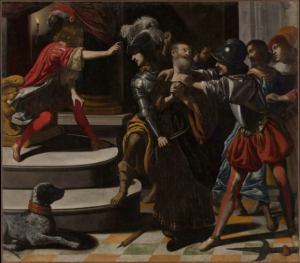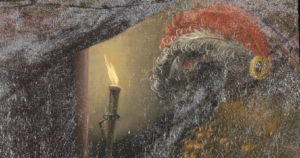Vittorio Sgarbi is a name that I have mentioned in articles several times before. He is a writer, art critic, and politician who, since November 2022, has served as one of the three undersecretaries for Italy’s Ministry of Culture. Given his position and outspoken nature, the foreign press often cites him whenever an incident that grabs people’s attention comes up. I have used his words when discussing Silvio Berlusconi’s art collection and attributing a lost painting to Raphael. However, he seems to be at the center of an unfolding scandal, the details of which have remained mainly in Italian publications. The scandal some call the Manetti Case seems straight from a decently written detective story involving a heist, a shady politician, and an attempt at a coverup, all centered around a seventeenth-century painting. But, to start with somewhat of a cliché, it all begins in an old castle.
Buriasco is a small town just outside of Turin in the far northwest of Italy. The town’s old castle, dating back to the early fourteenth century, is owned by Margherita Buzio, who rents it out as an event space. In February 2013, I imagine on a dark and stormy night, she noticed that one of the castle’s paintings was missing. Someone had cut it from its frame and replaced it with a reproduction. “It was too heavy to take it away like that, and they cut it, replacing it like they thought I wouldn’t notice,” Buzio told journalists. Buzio reported the incident to the Carabinieri, and the painting later appeared on Interpol’s stolen art database. They listed the work as The Judgment of Saint Paul, likely by a student of the southern Italian Baroque painter Francesco Solimena.
While stolen paintings often take years to track down, this one didn’t take long. Later that same year, around May, an incredibly similar painting popped up in Brescia in the hands of conservator Gianfranco Mingardi. According to journalists, Sgarbi told Mingardi he had a painting that needed some touching up. He claimed that his organization, the Cavallini Sgarbi Foundation, was the owner. Mingardi said the painting arrived “rolled up like a carpet.” He photographed the work and performed restoration until he returned it to Sgarbi in December 2018. Mingardi claimed that, given the circumstances, he suspected that the painting was, in his words, “hot”. He asked Sgarbi for documentation on the painting to prove he legally owned it, which Sgarbi could not produce.
Most recently, this painting was exhibited between December 2021 and October 2022 at the Cavallerizza, an old mansion used for art shows in the city of Lucca. It was part of an exhibition called I pittori della luce, or Painters of Light, which included works by Michelangelo da Caravaggio, Peter Paul Rubens, and Orazio Gentileschi. Sgarbi himself curated this exhibition and wrote the catalogue. In the notes, he refers to the painting as The Capture of Saint Peter, created in the mid- to late 1630s by the Sienese master Rutilio di Lorenzo Manetti. This was when some realized that Sgarbi’s painting bore a strange resemblance to a certain painting stolen from a castle near Turin eight years earlier. Sgarbi disputes that the painting ever came from that castle. He claims he found the painting in the attic of a villa his foundation had bought near Viterbo. According to the exhibition catalogue Sgarbi wrote, the painting is mentioned in an inventory compiled in 1649 listing the assets of Andrea Maidalchini, whose sister Olimpia previously owned the villa.
Italian journalists began covering the story in mid-December 2023. When confronted, Sgarbi dismissed any claims that his painting was the one stolen from Buriasco Castle, hurling insults and profanities as he went. This seems to be a recurring theme for him. As I read more about Sgarbi, it became apparent that he is known in Italy for being rather outspoken. Once, while serving in the Chamber of Deputies, he got ejected for hurling vulgarities at fellow deputies, with ushers carrying him out of the chamber by his arms and legs. It became clear why he was always ready to issue a comment on cultural matters. It has little to do with his position as a culture ministry official but his temperament as someone who finds it difficult to refrain from commenting on anything.
By December 17th, the investigative television program Report aired an episode on the subject. When Report’s team analyzed the 1649 inventory at the state archives in Viterbo, there was no mention of a painting by Manetti. The villa’s former owner, Luigi Achilli, who sold the property to Sgarbi’s foundation in 2000, insists that the villa was empty then. Forensic tests later showed that Sgarbi’s painting is likely the one stolen from Buriasco Castle. Because the painting was initially cut from its frame, pieces of canvas from the original painting were left behind. One particular scrap of canvas from the Buriasco painting’s bottom right corner that was left behind attached to the stretcher seems to match with a patch of new, repainted canvas inserted during restoration on the Lucca painting. Additionally, the stolen painting measured 247 by 220 centimeters, while the painting exhibited in Lucca measures 233 by 204. While a differently-sized canvas may indicate that it’s a separate painting, the fact that someone cut the Buriasco painting from its frame means that part of the canvas was left behind, attached to the stretcher and hidden behind the frame. If the stolen Buriasco painting were cut and then put on a new stretcher in a new frame, it would be smaller, just like the Lucca painting. This evidence would indicate that Sgarbi may have knowingly bought a stolen painting. However, one key piece of information reveals something possibly more nefarious.
According to Margherita Buzio, Sgarbi visited the castle, dined in its restaurant, and took a look at the painting in question. A man named Paolo Bocedi later offered to buy the painting at least twice, reportedly for €25,000. A few weeks after Bocedi’s offer, Buzio noticed the painting was missing. There is little information about Bocedi besides that he is a businessman from Lombardy and a close friend of Sgarbi. “We are linked by a friendship that has lasted for 25 years,” Bocedi once said in a November 2023 interview. In May 2013, when Sgarbi delivered the rolled-up painting to Mingardi, who was there to help drop off the painting? According to Mingardi, “a friend of Vittorio brought it to me together with a delivery man”. It was Paolo Bocedi accompanying the delivery truck on a motorcycle. Some journalists have taken this connection to mean that Sgarbi was involved indirectly in the initial theft.
One of the more potentially incriminating pieces of evidence that the Lucca painting offers is an additional feature not part of the painting stolen from the Buriasco Castle. In previous photographs of the painting, including those taken by Mingardi, there was no torch in the background above the judge’s head. However, the painting exhibited in Lucca includes a torch. Of course, it is not uncommon to find multiple versions of the same subject by the same artist. An artist’s popularity and the demand for their works incentivized them to create multiple copies. However, what is confusing is that the paint around the torch does not have the same craquelure as the rest of the painting. The pigment separation is even across the whole canvas but not around the torch. Thomas Mackinson, writing for the Italian newspaper Il Fatto Quotidiano, called it “La Candela Fantasma”, or the Ghost Candle. When presented with evidence that his painting may have been previously stolen, Sgarbi quickly cited the candle as evidence that his painting and the Buriasco painting could not possibly be the same work: “They are different, in mine there is a candle, the other is just a copy”. Furthermore, many have commented that it is incredibly rare for two versions of a work by the same artist (or even an original and a copy) to be completely identical in terms of color, light, and the proportion of its figures. This has led many to believe that the torch was added to the painting to throw off investigators and art historians. According to Alessandro Bagnoli, a professor of art history at the University of Siena, the mysterious torch “seems like an addition made specifically to diversify the painting presented at the Lucca exhibition from the one stolen from the Piedmontese castle.” If these accusations are true this, effectively, would be an attempt at laundering stolen art.
Based on what journalists and investigators have learned thus far, it appears that Sgarbi allegedly tried to buy a painting through an acquaintance, Paolo Bocedi. When that failed, the painting was stolen, cut from its frame and replaced with a replica. Later, a nearly identical painting was given to Gianfranco Mingardi for restoration. Suspecting that the painting may have been stolen, Mingardi returned it to Sgarbi in 2018. Sometime between then and the Lucca exhibition in 2021, someone added the mysterious torch, supposedly to throw off suspicions that it is the same painting stolen from Buriasco Castle. This, it seems, is enough evidence that prosecutor Giovanni Fabrizio Narbone announced on January 9th that Sgarbi will now be under investigation for laundering cultural assets.


